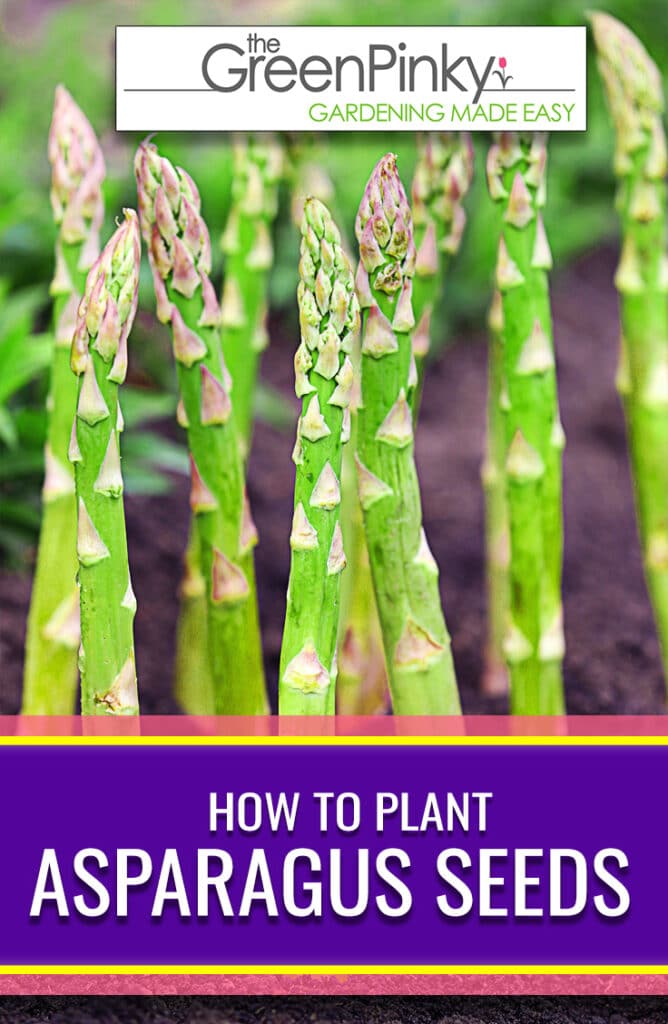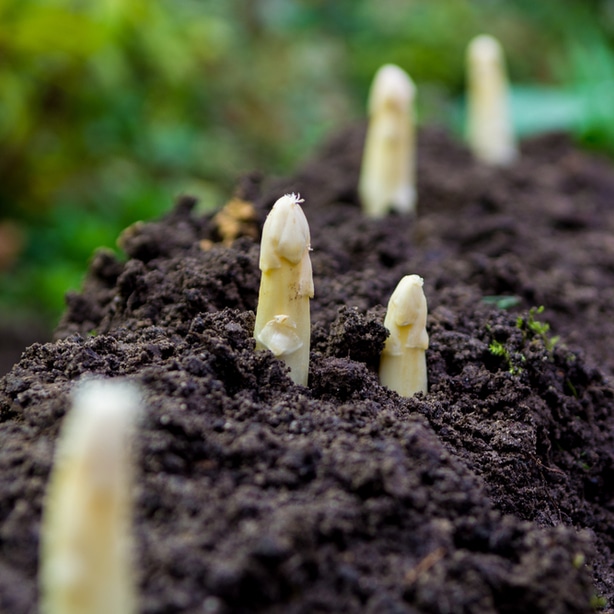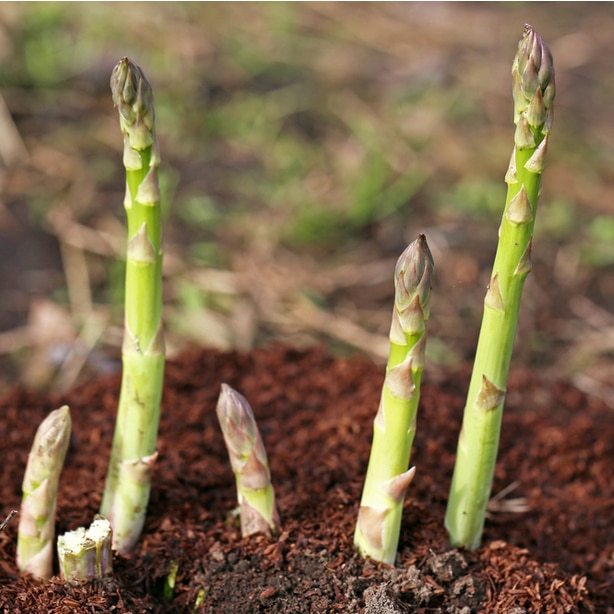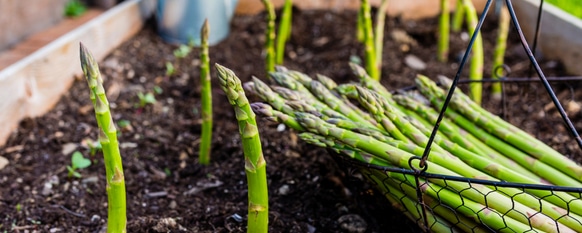Asparagus is one of those spring veggies we enjoy eating, but many people are hesitant to grow it in their garden. Instead, we love the adventure of hunting for the tender green spears along country roadsides and ditch banks. Gardeners courageous enough to grow their own typically plant young crowns, but it is possible to grow asparagus from seed.
Growing asparagus from seed isn’t difficult, but it is always helpful to learn about timing, plant spacing, and basic care to help grow the healthiest plants possible.
If you have arborvitae growing near your garden, you may notice that sometimes they turn brown. Here on the Green Pinky we will explain why arborvitae turn brown and what to do about it.

Basic Info
With its ability to grow wild along roadsides and riverbanks, it isn’t surprising to learn that Asparagus officinalis is a hardy perennial vegetable. Plants are native to Western Europe but can be found in USDA growing zones 2 through 8. Once established, a single crown will easily produce spears in the spring for 10 to 20 years.
The most vital thing to know about growing asparagus is the length of time until spears are harvestable. Plants grown from seed need three years of growth before you harvest. One-year-old crowns should be allowed to develop two more full seasons before harvesting; two-year-old crowns need another year of growth.
Benefits of Growing from Seed
Many gardeners opt to buy bare-root asparagus crowns to plant in their garden without giving a second thought to growing it from seed. Starting plants from seed does take a year or two longer to establish plants, but there are many benefits to sowing them indoors and transplanting them outside or direct sowing in the garden bed.
- Seeds are considerably cheaper than buying one-year or two-year-old crowns from a nursery or garden center.
- Seedlings started by homeowners have less chance of transplant shock compared to commercially grown crowns.
- Seeds offer a greater selection of varieties to choose from.
- Plants started from seed often result in crowns that produce a heavier harvest.
When to Plant
You can either start seeds indoors or direct sow them in the garden bed. Unless you live in warm climates with little or no chance of frost, it’s best to start asparagus indoors in mid-February or March to give them a jump start on the season. Direct sow outdoors when soil temperatures are between 70 and 85 degrees Fahrenheit.

Starting Seeds Indoors
To start seeds inside, soak them in water for a couple of hours to soften the seed coat and speed up germination. Plant them ½” deep, with one per 2” container; germination takes 2 to 8 weeks. Transplant seedlings when they are 10 to 12 weeks old and the threat of frost has passed.
Garden Bed Preparation
Crowns grow best in well-draining, fertile soil, with a pH close to neutral (6.5 to 7.2). Amend the soil with lime or an acidifying agent if it is significantly out of range. Work the garden bed to a depth of 12 inches and till in 1 to 2 pounds of 5-10-10 fertilizer — or equivalent — per 100 square feet of soil.
Hardening Seedlings
After the threat of frost has dropped in the spring, start hardening your seedlings. Hardening acclimates them to your outdoor climate, reducing transplant shock. Start by setting containers outside for a few hours in a spot protected from wind, bringing them in at night. Over the next 10 to 14 days, continually increase their exposure to the sun and wind.
Plant Spacing
Whether you are transplanting seedlings to the garden bed or direct sowing seeds, proper plant spacing is essential to give mature plants the space they need to take in adequate moisture and nutrients from the soil. Rows should be spaced three to six feet apart, and the spacing between plants in the rows determines how thick the spears grow.
- For thinner spears, plant transplants 4” deep and about 8 to 10” apart.
- For thicker spears, plant transplants 6 to 8” deep and 12 to 18” apart.

If you will be growing asparagus, check out our article on some great companion plants to grow alongside them.
Care Guide
Asparagus plants need the basics, just like any other garden vegetable — plenty of sunlight, adequate soil moisture, periodic application of nutrients, and little competition from weeds. The basic care practices will help ensure you grow the healthiest plants, and in turn, you’ll be rewarded with a bountiful harvest once crowns are established and harvestable.
Sunlight Requirements
Asparagus needs a great deal of sunlight. At, a minimum it prefers 8 hours of sun, but it will tolerate shade, especially during the hottest part of the day. If your garden gets shade during the day, try to plant crowns where they receive morning sunlight or sunlight earlier in the day, if possible.
Watering
The first two growing seasons keep the soil consistently moist to encourage root development and establishing, by applying 1 to 2” of water weekly to the garden bed. Especially during hot, dry periods in the summer. In year three and onward, you can drop the watering back down to about 1” of moisture weekly.
Fertilizing
Fertilizing asparagus plants is a little bit different than some of your other garden plants. It’s important to avoid heavy nitrogen fertilizer; the aim is to find a good balance between spear and root growth. Sprinkle a 5-10-10 fertilizer around the crowns early every spring, scratching it into the surface. Avoid ”hot” manures such as poultry, sheep, and swine.

Weeding
When growing in the wild, it isn’t unusual to find asparagus buried within a stand of weeds. However, it is essential to keep weeds at bay when grown in the garden to minimize competition for resources. Frequently watch for weeds and remove them when they sprout up close to your plants. You can also mulch around the plants to control weeds.
Growing Tips
Beyond the basic care requirements, growing asparagus is pretty straightforward, regardless of your gardening expertise. The following growing tips and tricks help boost plant growth, leading to more robust, healthier plants and better yields. You may know some of the following tidbits already, and some may be new to you, but you should definitely try them out.
- Always keep crowns covered with soil. This may mean regularly adding soil to the garden bed as your plants mature.
- Mound soil around the crowns to keep water from pooling at the base of the plant and causing rot.
- Plant near tomatoes if possible. Tomatoes repel the pesky asparagus beetle, and asparagus plants repel nematodes that attack tomatoes.
- Avoid planting near alliums and potatoes. Alliums hinder the growth of asparagus; asparagus stunts the growth of potatoes.
- Situate crowns on the north or eastern side of the garden, so the fall ferns don’t shade out shorter garden plants.
- Each fall, allow plants to set their ferns before cutting plants back to 2” before winter.
- Only remove spears for seven days in the first year of harvest, gradually increasing the harvest length until you reach a 6-week harvest window.

